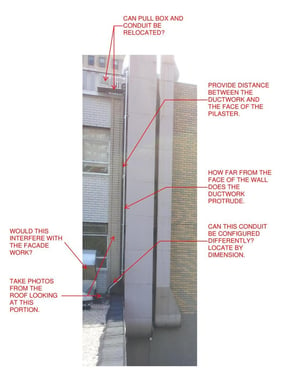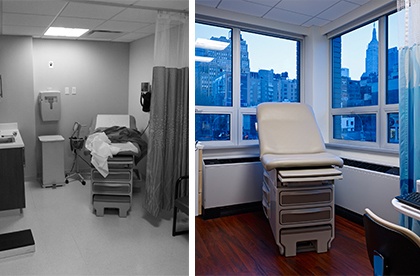Some buildings are historic; some are just old.
In most of Washington, DC, and certain historic districts in neighboring Virginia and Maryland, many of these older structures can’t be demolished or significantly altered on the exterior.
On the interior, they often have narrow column spacing, relatively low floor-to-floor heights, and congested mechanical and electrical rooms, as well as ADA issues with entrances, toilets, elevators and stairs. Potential hazardous materials and abandoned legacy infrastructure offer another layer of challenge. Many older buildings have “good bones” – but they need more than a facelift to accommodate modern medicine. Here are some creative solutions to work with the building’s bones.
1. Find those old drawings – but do a “hands on” field survey.
Bring a seasoned MEP engineer to the survey, one who knows (and probably designed) typical old systems. The CAD or BIM drawings are probably based on measuring the interior space, which only documents the visible interior dimensions. What’s behind those thick walls and mystery bump outs? Ask for a few test holes to take a peek behind the walls. We use a pre-finished access door to cover up the hole, allowing the team future visual observations as the work progresses.
2. What you see doesn’t have to be what you get.
You’ll be amazed at what you may find when you remove the flooring in key areas. We’ve found multiple layers of old tile, carpet and sometimes a sound terrazzo floor under it all. Similarly, the drywall in the lobby may be hiding a mural or millwork gem. You can restore an area to its former glory by reclaiming and stabilizing the old finishes, which can work well in lobbies and sub-waiting areas. Aesthetically, this is much better than an old, faded photo of what the space used to look like.
3. An outboard corridor with borrowed light to the interior creates options.
The new corridor can provide a fresh, proper-height ceiling plenum path for new utilities. Additionally, it can allow higher ceilings in the center, which are ideal for imaging equipment or procedure rooms.
4. Consider creating a new vertical service core – the old shafts are probably full.
The ne w core will allow new piping and ductwork to be provided while the old system continues to run in the existing chase or plenum. Old buildings usually have cramped vertical shafts with old utilities risers. These old shafts are often adjacent to elevator or stair cores that restrict access. A new vertical core in a less restricted location can allow new utilities the vertical space they need, better access and horizontal “take off” geometry for branch services.
w core will allow new piping and ductwork to be provided while the old system continues to run in the existing chase or plenum. Old buildings usually have cramped vertical shafts with old utilities risers. These old shafts are often adjacent to elevator or stair cores that restrict access. A new vertical core in a less restricted location can allow new utilities the vertical space they need, better access and horizontal “take off” geometry for branch services.
5. Discuss Phasing up front, not as a last step.
The space available up front, what new space is needed, new infrastructure requirements, equipment access or ease of construction sequencing are all factors in phasing requirements. I often find that these factors are not in alignment, especially for older structures. The sequencing for renovations in older buildings is not the “construction trade logic” of new construction or initial tenant build out. Planning, programming, construction documents, temporary utilities, permit packages and phased occupancy all need to reflect the interim sequencing.
To facilitate phased construction and work around adjacent occupied space, consider modular design and pre-fabrication techniques – less on-site work, more in the shop. The Mechanical and Electrical trades already use this approach – extend it to include modular casework, pre-finished doors and frames, and other such integrated assemblies versus individual pieces requiring field finishing by multiple trades.
Overall, older structures have a lot to offer, not the least includes a sustainable approach by adaptive reuse, preservation of an architectural gem and a completely built-out space in a desirable part of town. The challenges of upgrading systems and tapping creativity to ‘make the space work’ are good challenges and ones that designers should take on. Older buildings were thoughtfully designed, well-constructed and can provide several more decades of service with the right approach.
This post was written by Martin Reddy, who has retired from Array.


